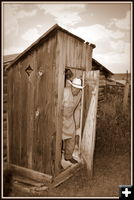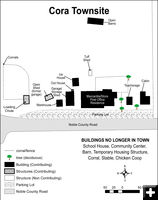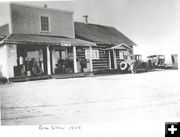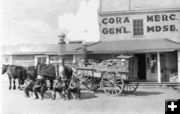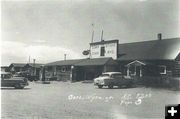
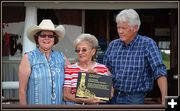
Ann Noble, Joann Ludwig and Clint Gilchrist
L to R: Historian Ann Noble, who wrote the National Register nomination for the Cora Townsite. Joann Ludwig, who currently owns the property, receives the dedication plaque from Clint Gilchrist, President of the Sublette County Historic Preservation Board-CLG.
|

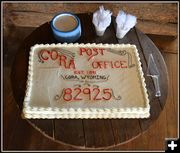
The Cake
Designed after the sign in front of the building.
|
|
Cora Townsite Celebration 2017
Historic Cora townsite recently listed on the National Register of Historic Places
by Terry Allen
July 14, 2017
Past owners, employee's, interested residents and visitors and those dedicated to documenting our history got together Friday July 14, 2017 to celebrate the recent listing on the National Register of Historic Places. There was a potluck BBQ, self-guided tours of the buildings, a history talk by historian Ann Noble, and a presentation of the National Register plaque to Joanne Ludwig.
Jonita Sommers agreed to introduce me to historic people and share some of her own remembrances. "We used to stop here when we were driving cattle north on the Drift," she said. "It had a small store back then. There was no bar. The beer was sold in the store. Doug Price would give me a silver dollar. You could buy pop, Vienna sausages and crackers. There was a rack of comic books which I sat and read."
Linda Anderson shared that a couple of cabins from elsewhere in the county were moved in and joined together to form the house. "Dad collected all these wagon wheels from around the county to make the yard fence," she said. "Every Sunday that's what we did. It was our Sunday outing."
I overheard Linda and another woman saying they acted as clothing models at the store when they were little girls.
Lauri Hartwig introduced me to her grand daughter from Iowa and Marley agreed to be the model to show off the wagon wheel fence in as artistic way as I could manage.
Ann's daughters Zoe and Laura were busy taking pictures with Ann's new Nikon camera so I went over to get their impressions of the work their Mother does in telling the history of our county. "She gets up at 3:am in the morning, types and drinks coffee...a lot of it," they said. "This is pretty much her daily routine. Sometimes we find her asleep on the floor when we wake up."
I guess that answers my question on how Ann manages to get so much done.
I spend some enjoyable time with Tina Nelson and Sam Nelson. Sam agreed to re-enact a character from the past coming out of the fully functional two-holer that still sits on the property. "We used to have a two-holer that sat right on the main street," said Tina. "Memories are a little unsure of who it was...could have been Grand dad Clemons or James Mark Noble, but one of them liked to sit there with the door cracked open so he could see people coming down the road and stop them so he could talk to them.
If anyone was a party to some of those conversations, I'd sure like to hear them, write them down and share them. I bet they were interesting, funny and reflected the times.
Thank you, Dawn Ballou for hiring me to attend this event and take photos and write down impressions.
______________________________
History
A typical Wyoming rural town
By Ann Chambers Noble
Early on, the town of Cora was founded to support the early settlers. Starting in 1898, James Noble had a general store at his Cora ranch about a mile east on the New Fork River that was patronized by area ranchers. The town also supplied area guest ranches that opened about the same time ranching did in the northern parts of Cora Valley and the Upper Green River area. The store was also the location for the Cora Post Office. For a short time, men working at a tie camp in Kendall, located north of Cora approximately 22 miles, also patronized Noble’s store. But for the majority of time the camp was open, from 1896 until it shut down in 1904, Kendall had its own post office.
A few of the talented tie hacks working in Kendall stayed in the area and were valuable builders. Eddie Edwards, a tie hack, constructed many of the buildings on the Noble ranch. These buildings are hand-hewn sturdy logs that were transported from the Upper Green River near the tie camp. Two of these structures, the Cora Store and a warehouse, would be moved to a new townsite in 1919. These buildings display exceptional log craftsmanship.
The evolution of transportation had a formidable impact on the development and decline of the Cora townsite throughout the twentieth century. With the introduction of motorized vehicles, the wagon road up the Cora Valley became obsolete. The original road followed the New Fork River, making motorized vehicle travel difficult for most of the spring and irrigation season. Therefore, the State moved the road to higher ground one mile west of the Noble ranch and original townsite.
In 1919, Henry Clodius revived the Town of Cora, which by then had been experiencing an economic decline on the Noble ranch. Recognizing the importance of the new road, Clodius moved two of the structures from Noble’s ranch and started a new Cora. The townsite has remained at this location to the present.
Cora would have been a typical Wyoming rural town in the twentieth century. Located along Wyoming Highway 352 starting in 1919, within a short time it housed a store, post office, school, teacherage, and community center, in addition to some residential housing. Cora was sustained by continued ranching community patronage. The town’s economy was also assisted by guest ranches operating in the northern part of Cora Valley and the Upper Green River area especially until World War II.
With improved transportation, the school, teacherage and community center closed as residents now easily traveled to Pinedale for school and socializing. In time, the Cora store would also close for the same reason: people traveled farther, easier, and more often. The Cora Post Office, however, is still active and patronized by local residents.
|
